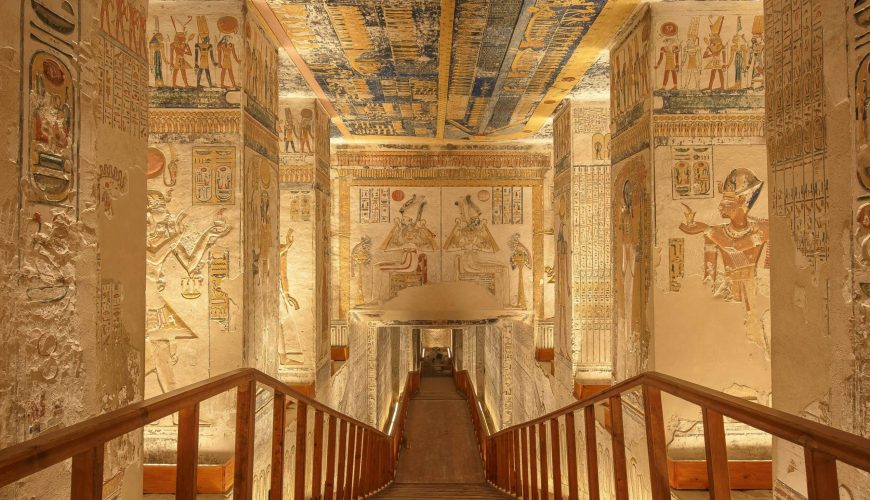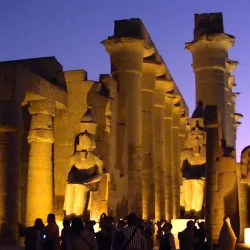The Valley of the Kings, located on the west bank of the Nile near Luxor, Egypt, is one of the most famous archaeological sites in the world. It served as the royal burial ground for the pharaohs and powerful nobles of the New Kingdom (approximately 1539-1075 BCE). The valley, nestled in a desolate and rugged area, contains over 60 tombs, including those of some of Egypt’s most illustrious rulers, such as Tutankhamun, Seti I, and Ramesses II.
Deep within the heart of the Theban Necropolis, on the west bank of the Nile River, lies a place shrouded in mystery and majesty – the Valley of the Kings. This desolate valley wasn’t just any wasteland; for centuries, it served as the final resting place for Pharaohs of the New Kingdom, meticulously carved into the mountainside to protect them on their journey to the afterlife.
Valley of the Kings Historical Background

The Valley of the Kings was used for burials for nearly 500 years during the New Kingdom period. The decision to establish this royal necropolis was driven by the desire to protect the tombs from grave robbers, a common problem with the more visible pyramid tombs of earlier dynasties. The secluded location and the construction of hidden tombs within the valley’s cliffs were intended to safeguard the treasures and the bodies of the pharaohs.
Unlike towering pyramids, the Valley of the Kings boasts a network of elaborate tombs burrowed deep underground. Imagine a labyrinthine necropolis, each tomb unique in its design and decoration. Over 60 tombs have been discovered so far, offering a fascinating glimpse into the beliefs and practices of the ancient Egyptians.
Valley of the Kings Tombs and Architecture

Descending into a tomb is like stepping back in time. The walls are adorned with colorful paintings and hieroglyphs depicting scenes from the Pharaoh’s life, religious rituals, and offerings to the gods. These detailed illustrations provide invaluable insights into the ancient Egyptian worldview and their obsession with the afterlife.
The tombs in the Valley of the Kings vary greatly in size and complexity, reflecting the wealth and status of the individuals buried within them. Some of the notable features include:
- KV62 (Tomb of Tutankhamun): Perhaps the most famous tomb in the valley, discovered by Howard Carter in 1922. The tomb was found largely intact, with a wealth of artifacts that have provided invaluable insights into the life and death of the young pharaoh.
- KV17 (Tomb of Seti I): One of the longest and most beautifully decorated tombs, belonging to Seti I. The walls are adorned with intricate and colorful reliefs and hieroglyphs depicting scenes from various religious texts.
- KV5: The largest tomb in the valley, originally intended for the sons of Ramesses II. It contains over 120 chambers, making it one of the most complex and extensive tombs in the valley.
- KV34 (Tomb of Thutmose III): Located high in a cliff, this tomb features unique decoration styles and is notable for its well-preserved wall paintings that include scenes from the Amduat, a funerary text.
Artistic and Cultural Significance
The Valley of the Kings is more than just a collection of tombs; it’s a window into the soul of ancient Egypt. Here, pharaohs weren’t just buried; they were reborn into the afterlife, surrounded by their most prized possessions and protected by powerful spells. Exploring the valley allows us to connect with these long-gone rulers and gain a deeper appreciation for the rich tapestry of Egyptian civilization.
The tombs in the Valley of the Kings are adorned with elaborate murals, carvings, and inscriptions. These decorations are not merely ornamental but serve significant religious purposes, guiding the deceased through the afterlife and ensuring their safe passage to the realm of the gods.
The Book of the Dead, the Amduat, and other funerary texts are commonly depicted on the walls of the tombs, illustrating the journey of the soul and the various challenges it faces. These texts and images provide critical information about ancient Egyptian beliefs regarding death, the afterlife, and the gods.
Preservation and Modern Challenges
Preservation of the Valley of the Kings is a significant challenge due to factors such as tourism, environmental changes, and ancient construction techniques. The influx of visitors can lead to the deterioration of the fragile tomb walls, and efforts are continuously made to balance access with conservation.
Several tombs have been closed to the public to preserve their delicate murals and structures. In recent years, the Egyptian government and international organizations have undertaken extensive preservation projects, employing modern technology to monitor and protect the site.
Modern Relevance and Tourism
The Valley of the Kings remains a major tourist attraction, drawing visitors from around the globe who are eager to explore the burial sites of ancient Egypt‘s most famous pharaohs. Guided tours offer insights into the history, significance, and discoveries associated with the valley.
Additionally, the ongoing archaeological work in the valley continues to yield new discoveries and insights, keeping the Valley of the Kings at the forefront of Egyptological research and contributing to our understanding of ancient Egyptian civilization.
The Valley of the Kings is not only a monumental archaeological site but also a cultural treasure that offers a profound connection to the ancient past. Its tombs and the artifacts within them continue to captivate the imagination and provide valuable knowledge about the rich history of Egypt.
It’s important to note that due to preservation concerns, visitor access to specific tombs is rotated and limited. However, even a glimpse into these subterranean sanctuaries is enough to leave you awestruck. The Valley of the Kings offers a unique opportunity to unravel the mysteries of ancient Egypt and feel the presence of its pharaohs who continue to reign from beyond the grave.
Would you dare to enter the Valley of the Kings? Share your thoughts in the comments below!














0 Comment